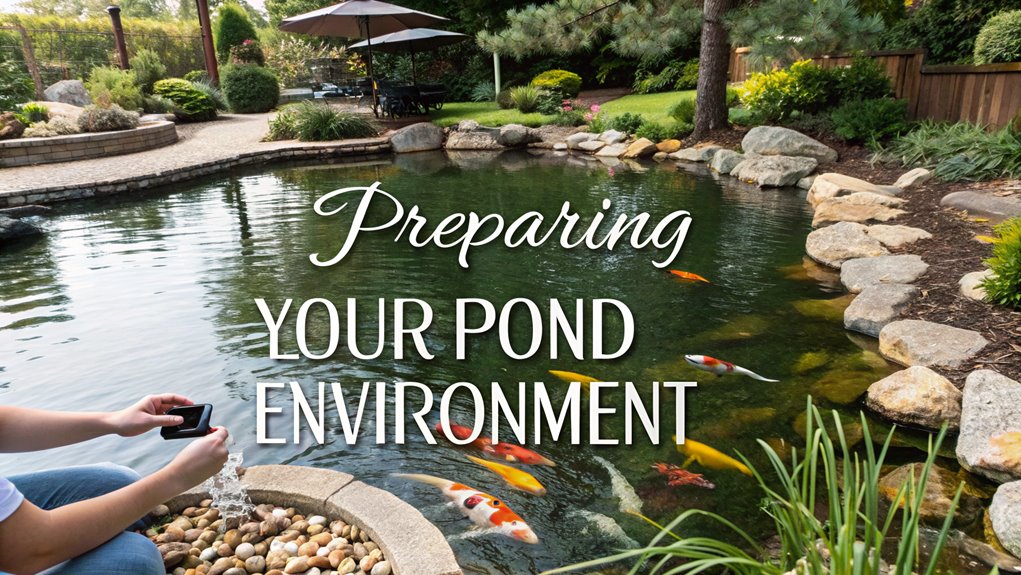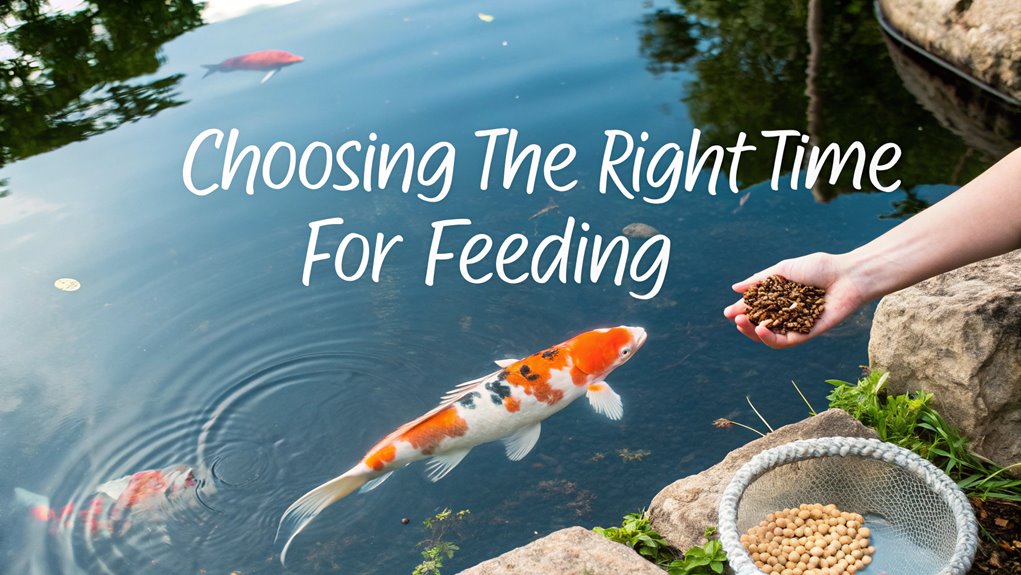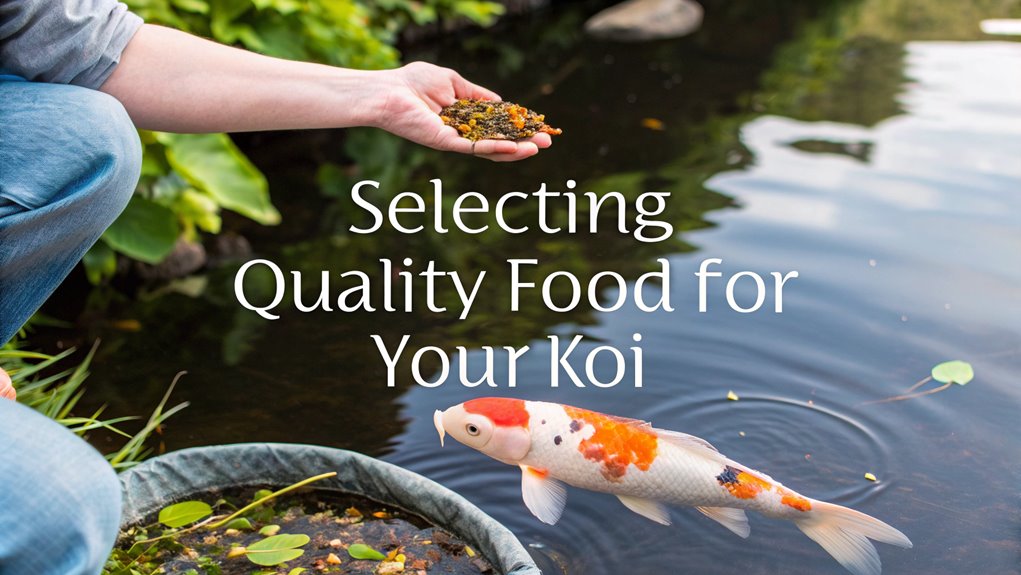To hand-feed your koi safely and effectively, maintain water quality and feed only when the temperature is above 55°F. Choose high-quality floatable food like Manda Fu, and establish a consistent feeding schedule. Position your hand still in the water, allowing koi to approach at their own pace. Ensure your hands are clean, free from oils. Keep a calm demeanor to foster trust. If you continue, you’ll uncover more strategies to bond with your koi.
Key Facts Summarized
- Ensure hands are clean and free from oils or lotions before feeding.
- Place your hand still in water to let koi approach naturally.
- Use high-quality, floating koi food to encourage surface feeding.
- Maintain a consistent feeding schedule to build trust and familiarity.
- Avoid sudden movements or loud noises to keep the environment calm.
Preparing Your Pond Environment

Before you start hand-feeding koi, it’s essential to prepare the pond environment to ensure their health and well-being.
Begin by maintaining the water quality in your koi pond, as it’s critical for their survival. Ensure the water temperature remains above 55 degrees Fahrenheit. Cold conditions hinder digestion, negatively impacting koi health.
Regularly test water parameters—pH, ammonia, nitrite, and nitrate levels—to detect imbalances. A clean, well-filtered, and oxygenated pond supports koi activity and happiness. Additionally, monitor ammonia levels to ensure they remain at 0 mg/liter to prevent toxicity and stress in your koi.
Incorporate diverse elements like plants and hiding spots to mimic their natural habitat, enhancing comfort.
Establish a consistent feeding routine at the same time and place daily. This consistency builds trust, encouraging koi to approach you, making it easier to feed your koi by hand.
Choosing the Right Time for Feeding

When is the best time to feed your koi? To ensure healthy koi, consider these crucial factors:
- Water Temperature: Only feed koi when water consistently remains above 55°F. Below this, they may refuse food, risking their health.
- Routine Establishment: Feed koi at the same time daily. This predictability enhances their security, making them more receptive to feeding koi quality food.
- Weather Considerations: Avoid feeding during extreme weather, such as heavy rain or thunderstorms, which can stress the fish and reduce their appetite.
Monitor their behavior post-winter dormancy. Observe when they appear most eager, as this is often the optimal time for feeding. Additionally, be mindful of signs of illness, as these can affect their willingness to eat and overall health.
Selecting Quality Food for Your Koi

Selecting quality food for your koi is paramount, as it directly influences their health, coloration, and overall vitality. High-quality koi food, like Manda Fu by Kodama Koi, boasts a 98.2% digestion rate, ensuring optimal nutrient absorption. Such food enhances their color and supports robust health.
When hand feeding, floating food is preferred, encouraging koi to surface and engage with you. This interaction fosters trust and strengthens the bond between you and your koi. Avoid junk food, which can harm their health and degrade water quality, leading to disease.
Seasonal feeding is essential; Manda Fu remains effective even at temperatures as low as 45°F-50°F. Consistently providing quality food promotes active foraging, happiness, and energy, enhancing your koi’s well-being. Additionally, a diet rich in essential nutrients for growth can significantly improve your koi’s vibrancy and overall health.
Techniques for Encouraging Koi Trust
To foster trust with your koi, begin by placing your hand still in the water, allowing the fish to approach at their own pace. This calm presence shows koi LOVE and helps train your Koi to see you as a non-threatening part of their environment.
Here are some techniques:
- Routine Feeding: Feed them consistently at the same time each day. This regularity helps build familiarity and trust.
- Short Fasting Periods: Introduce food after brief fasting periods to increase their eagerness to engage, enhancing trust-based interactions.
- Observe Koi Behavior: Pay attention to individual koi’s actions. Often, a daring fish leads, encouraging others to follow, thus building collective trust.
Additionally, maintaining pond conditions is essential for promoting a safe environment that fosters trust and interaction between you and your Koi.
These maintenance tips will effectively train your Koi, ensuring a trusting and harmonious relationship.
Training Koi to Approach for Feeding
Although training koi to approach for feeding requires patience and consistency, the process can be rewarding. To effectively feed koi, start by withholding food for 5 days to heighten their interest. Choose a specific feeding spot to establish a routine. Throw small food amounts consistently, fostering beautiful koi associations with that location. Maintain a calm demeanor; sudden movements can hinder koi health by causing stress. Observe their cautious behavior and let them approach naturally. Proper water quality management is also essential during this training to ensure the koi remain healthy and responsive.
| Day | Action | Observation |
|---|---|---|
| 1 | Withhold food | Increased curiosity |
| 2 | Continue withholding | Noticeable hunger |
| 3 | Initiate feeding spot | Cautious approach |
| 4 | Small food amounts | Gradual trust building |
| 5 | Repeat consistently | Strengthened association |
Consistency is key to cultivating their trust, ensuring a healthy feeding relationship.
Safe Practices for Hand Feeding
As you establish a routine for feeding koi, it’s important to implement safe practices to ensure their well-being.
Begin by ensuring your hands are clean and free from oils or lotions, which could damage their delicate skin. Use high-quality koi food like Manda Fu or Mr. Kodama Koi Food to enhance both health and feeding experience.
Follow these steps:
- Feed Individually: Offer koi treats in small amounts to avoid overfeeding and maintain optimal water conditions.
- Patience and Calmness: Maintain a calm demeanor, allowing koi to approach at their own pace, building trust and reducing stress.
- Monitor Water Conditions: Regularly check oxygen levels and cleanliness to ensure a safe environment during feeding sessions.
Observing and Understanding Koi Behavior
Understanding koi behavior is essential for effective care and management. Observing koi closely helps you identify their happiness through active swimming and social interactions, reflecting a healthy environment. Each koi exhibits unique personalities, so understanding individual behavior ensures tailored care. Notice changes like disinterest in food or abnormal swimming, as they might indicate stress or environmental dissatisfaction. Ensure healthy water quality; poor conditions lead to gasping or lethargy.
| Observation | Koi Behavior | Interpretation |
|---|---|---|
| Active Swimming | Engaged and Healthy | Favorable Environment |
| Social Interaction | Playful or Reserved | Unique Personality |
| Disinterest in Food | Potential Stress | Environmental Issue |
| Abnormal Swimming | Distress Indication | Check Water Quality |
Regular interaction and feeding routines build trust, making koi more responsive to your presence.
Maintaining a Healthy Bond With Your Koi
Developing a healthy bond with your koi requires consistent and mindful interaction. Regular hand-feeding sessions are pivotal for fostering trust and enhancing your koi’s responsiveness.
To effectively maintain this bond:
- Observe Behavior: Monitor your koi during hand-feeding to understand individual personalities and preferences. This observation allows you to tailor interactions, strengthening the bond.
- Consistent Routine: Establish a regular feeding schedule. Consistency helps koi recognize you, reinforcing their trust and encouraging them to approach willingly.
- Quality Nutrition: Use high-quality food like Manda Nishiki. It supports koi health and enriches the hand-feeding experience, making each session beneficial.
Patience is crucial. Respect your koi’s comfort levels to nurture a trusting relationship over time, ensuring a closer connection.
Frequently Asked Questions
How to Hand Feed Your Koi?
Begin by reducing feeding to increase koi hunger. Choose a consistent spot, use floating pellets, and maintain calmness to attract koi. Feed daily at the same time. Ensure hands are clean, free from oils or lotions.
Do Koi Fish Recognize Their Owners?
Koi symbolize memory and recognition. You’ll notice how they identify you through consistent patterns, like feeding times. Their intelligence means they remember faces, rewarding your care with loyalty. Your presence becomes a trusted symbol of nourishment.
What Is Proper Koi Feeding?
You should provide high-quality, koi-specific food and maintain a consistent feeding schedule. Avoid feeding below 55°F to prevent stress. Feed them only what they can consume in 5-10 minutes to ensure optimal health and water quality.
When Should You Not Feed Koi Fish?
You shouldn’t feed koi when water’s below 55°F, or if they’re stressed, showing distress, or during poor water quality. You might think it’s okay if they’re hungry, but it harms their health.
Conclusion
Hand-feeding koi is like building a bridge, connecting you to your aquatic friends. Just as engineers carefully plan each step, you’ve prepared your pond, chosen the right time, and selected quality food. By earning their trust and understanding their behavior, you ensure a safe and rewarding experience. Imagine your koi gently nibbling from your hand, a testament to your patience and dedication. This bond, much like a well-constructed bridge, is strong, enduring, and deeply satisfying.


